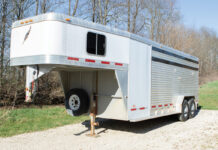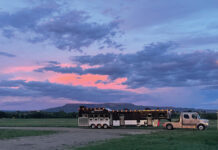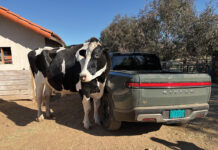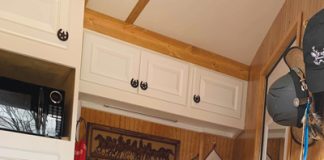 Whoa! Wait a minute. Too often we’re in such a hurry to head down the road that we don’t stop to think how a trailering trip can cause both stress and injury to our horses if we aren’t careful. Whether you’re off for a long haul or just a trip down the road, here are 10 considerations that will help ensure your horse arrives safe and serene.
Whoa! Wait a minute. Too often we’re in such a hurry to head down the road that we don’t stop to think how a trailering trip can cause both stress and injury to our horses if we aren’t careful. Whether you’re off for a long haul or just a trip down the road, here are 10 considerations that will help ensure your horse arrives safe and serene.
2. Bring on the bell boots. If your shipping boots don’t quite cover your horse’s sensitive heels, add bell boots to his traveling ensemble. They’re an inexpensive investment and can shield your horse from a painful, costly wound if he accidentally steps on himself.
3. Consider a cranium cushion. If your horse is naturally high-headed or if he’s acquired the habit of raising his head while loading, you can protect him from a whack on the poll with a head bumper. The cap fits over his ears and slips onto his shipping halter.
4. To blanket or not to blanket; that is the question. Heat and humidity tend to build up inside an enclosed trailer, even when it’s chilly outside. The more horses on board, the warmer it can get. Consider the number of equine passengers, the ventilation of the trailer and the length of your journey before deciding to blanket your horse during transit. He shouldn’t get the shivers. But he shouldn’t feel like a steamed clam, either.
5. Should you saddle for convenience? Travel the southwest and it’s not unusual to see a stock trailer with a string of cowponies inside, already saddled so they can hop out and go right to work. That might look like a good idea if you and your friends are hyper-excited about your upcoming trail ride. But remember that the stirrups on a western saddle can get hung up on the walls and dividers of a straight or slant-load trailer, spooking your horse and impeding the unloading process. Plus, your horse will be tacked up for hours once you get where you’re going. Should he have to wear his saddle on the way there, too?
6. Add a scoop of shavings. Sprinkling several inches of stall bedding on the floor of your trailer softens the ride for your horse and it’s an additional barrier between the heat of the road. Shavings also preserve your trailer mats and aid in clean up.
7. Don’t forget the beverages. Pack an unopened gallon bottle of water for each horse you’re hauling, plus a clean bucket. Stow them in the tack compartment of your trailer. It’s a safety measure in case you get stuck somewhere or if there isn’t any water at your destination.
8. Pack a “just in case” kit. Put together a simple first aid kit for your horse and keep it on board your trailer at all times. Consider commonsense items like simple bandages and a roll of Vetrap.
9. Make some snap decisions. Use ties with quick-release snaps to tether your horse in the trailer. That way you don’t have to fumble to undo a knot or fiddle with a bull snap in an emergency. Select trailer ties that are long enough to permit your horse to move his head and neck around to reach his food and so that he doesn’t feel trapped. Yet they must be short enough to keep him from annoying his companion or getting his head over the divider.
10. Cruise in control. There’s no room for pilot error when hauling horses. Remember that you’re hauling live cargo, not a motor boat or an RV. Each time you brake or turn the horses in the back have to shift their weight. Zipping around turns and stopping short increase the stress on the horses in your care. Be a conscientious driver, provide a smooth trip, and your horse will really think he’s traveling in style.
Further Reading
Safe Trailering Tips
Trailering Checklist






Very good article. Keep us informed on horse care of all kinds.
Excellent common sense tips for trailering. Reminders always are appreciated.